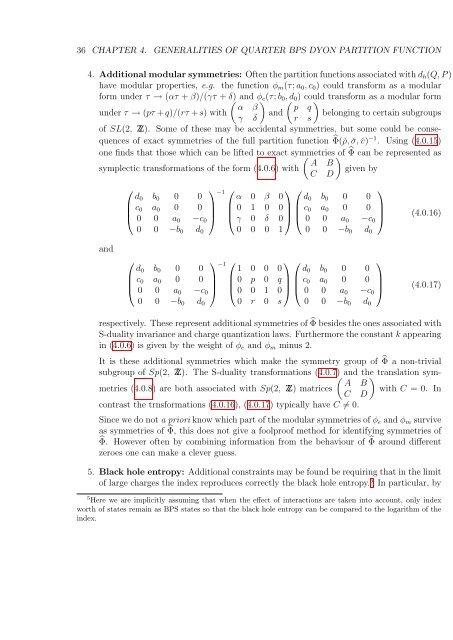PHYS08200604018 Shamik Banerjee - Homi Bhabha National ...
PHYS08200604018 Shamik Banerjee - Homi Bhabha National ...
PHYS08200604018 Shamik Banerjee - Homi Bhabha National ...
Create successful ePaper yourself
Turn your PDF publications into a flip-book with our unique Google optimized e-Paper software.
36 CHAPTER 4. GENERALITIES OF QUARTER BPS DYON PARTITION FUNCTION<br />
4. Additional modular symmetries: Often the partition functions associated with d h (Q, P )<br />
have modular properties, e.g. the function φ m (τ; a 0 , c 0 ) could transform as a modular<br />
form under τ → (ατ + β)/(γτ + δ) ( and φ)<br />
e (τ; b 0 ,( d 0 ) could ) transform as a modular form<br />
α β p q<br />
under τ → (pτ + q)/(rτ + s) with and belonging to certain subgroups<br />
γ δ r s<br />
of SL(2, Z). Some of these may be accidental symmetries, but some could be consequences<br />
of exact symmetries of the full partition function ̂Φ(ˇρ, ˇσ, ˇv) −1 . Using (4.0.15)<br />
one finds that those which can be lifted to exact symmetries ( ) of ̂Φ can be represented as<br />
A B<br />
symplectic transformations of the form (4.0.6) with<br />
given by<br />
C D<br />
⎛<br />
⎞<br />
d 0 b 0 0 0<br />
⎜ c 0 a 0 0 0<br />
⎟<br />
⎝ 0 0 a 0 −c 0<br />
⎠<br />
0 0 −b 0 d 0<br />
⎞ ⎛<br />
⎞<br />
α 0 β 0 d 0 b 0 0 0<br />
⎜ 0 1 0 0<br />
⎟ ⎜ c 0 a 0 0 0<br />
⎟<br />
⎝ γ 0 δ 0 ⎠ ⎝ 0 0 a 0 −c 0<br />
⎠ (4.0.16)<br />
0 0 0 1 0 0 −b 0 d 0<br />
−1 ⎛<br />
and<br />
⎛<br />
⎞<br />
d 0 b 0 0 0<br />
⎜ c 0 a 0 0 0<br />
⎟<br />
⎝ 0 0 a 0 −c 0<br />
⎠<br />
0 0 −b 0 d 0<br />
⎞ ⎛<br />
⎞<br />
1 0 0 0 d 0 b 0 0 0<br />
⎜ 0 p 0 q<br />
⎟ ⎜ c 0 a 0 0 0<br />
⎟<br />
⎝ 0 0 1 0 ⎠ ⎝ 0 0 a 0 −c 0<br />
⎠ (4.0.17)<br />
0 r 0 s 0 0 −b 0 d 0<br />
−1 ⎛<br />
respectively. These represent additional symmetries of ̂Φ besides the ones associated with<br />
S-duality invariance and charge quantization laws. Furthermore the constant k appearing<br />
in (4.0.6) is given by the weight of φ e and φ m minus 2.<br />
It is these additional symmetries which make the symmetry group of ̂Φ a non-trivial<br />
subgroup of Sp(2, Z). The S-duality transformations (4.0.7) ( and the ) translation symmetries<br />
(4.0.8) are both associated with Sp(2, Z) matrices<br />
with C = 0. In<br />
A B<br />
C D<br />
contrast the trnsformations (4.0.16), (4.0.17) typically have C ≠ 0.<br />
Since we do not a priori know which part of the modular symmetries of φ e and φ m survive<br />
as symmetries of ̂Φ, this does not give a foolproof method for identifying symmetries of<br />
̂Φ. However often by combining information from the behaviour of ̂Φ around different<br />
zeroes one can make a clever guess.<br />
5. Black hole entropy: Additional constraints may be found be requiring that in the limit<br />
of large charges the index reproduces correctly the black hole entropy. 5 In particular, by<br />
5 Here we are implicitly assuming that when the effect of interactions are taken into account, only index<br />
worth of states remain as BPS states so that the black hole entropy can be compared to the logarithm of the<br />
index.

















